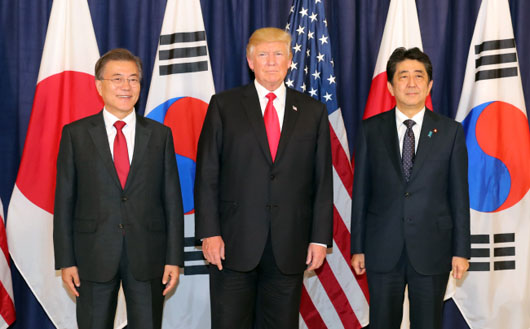Analysis by WorldTribune Staff, September 12, 2017
Since the mid-Twentieth Century, it has fallen to the United States of America to deal with apocalyptic and devastating crises around the world including the World Wars and the Cold War.
The emergence on the world stage in 2017 of North Korea — a belligerent communist rogue state terrorizing U.S. allies in the region and even the American heartland with its new weapons of mass destruction — has the world in suspense. What will the Americans do?

In a Twitter post last week, President Donald Trump said, “I am allowing Japan & South Korea to buy a substantially increased amount of highly sophisticated military equipment from the United States.”
Is Pax Americana done or is it just entering a new phase?
According to a report in the New Yorker, Barack Obama warned the new tenant at the White House that North Korea would be his ultimate and immediate challenge. The new president told aides, according to the report that “I will be judged by how I handle this.”
Trump has made several calls to world leaders in recent days to discuss the threat posed by North Korea.
On Sept. 12, he spoke with UK Prime Minister Theresa May and Australian Prime Minister Malcolm Turnbull. Last week, Trump spoke with Japanese Prime Minister Shinzo Abe, German Chancellor Angela Merkel, and South Korean President Moon Jae-In.
Japan’s Abe is a hawk on North Korea and has proven to be a staunch and consistent U.S. strategic ally in recent years as China has sought to dominate the all-important sea lanes in the region. South Korea’s Moon, however, ran on a dovish platform advocating dialogue with the North.
A dose of geopolitical reality since taking office in May plus several close encounters with President Trump has impacted Moon’s game plan, if not his ideological stripes.
South Korean Defense Minister Song Young-Moo said that a special forces “decapitation unit” would be established by the end of the year that would disable the regime’s leadership in the event of war.
The South’s military has been retooling helicopters and transport planes to penetrate North Korea at night so that the forces, known as the Spartan 3000, can carry out raids, a New York Times report said.
“The best deterrence we can have, next to having our own nukes, is to make Kim Jong-Un fear for his life,” said Shin.
Trump has also agreed to lift payload limits under a decades-old treaty, allowing South Korea to build more powerful ballistic missiles.
Seoul is developing its own L-SAM interceptor missiles, as well as installing more early warning radars for ballistic missiles, according to the Sept. 12 report by the Times.
Washington’s decision to lift the missile payload limits may allow South Korea to develop new Hyunmoo missiles capable of destroying weapons sites and leadership bunkers deep underground, said Seoul-based analyst Shin Jong-Woo of the Korea Defense Forum.
Shin said there was talk of building a Hyunmoo with a two-ton warhead.
The earlier restrictions barred South Korea from attaching a payload weighing more than half a ton to its Hyunmoo missile when the rocket had a range of up to 497 miles.
“We can now build ballistic missiles that can slam through deep underground bunkers where Kim Jong-Un would be hiding,” said Shin Won-Sik, a three-star general who was the South Korean military’s top operational strategist before he retired in 2015.
“The idea is how we can instill the kind of fear a nuclear weapon would – but do so without a nuke. In the medieval system like North Korea, Kim Jong-Un’s life is as valuable as hundreds of thousands of ordinary people whose lives would be threatened in a nuclear attack.”
South Korea also plans to upgrade its PAC-2 interceptor missiles for a better low-altitude defense. For higher altitude defense, South Korea expedited delayed plans by the U.S. military to install additional THAAD missile-defense batteries.
Moon campaigned against THAAD and initially balked at installing additional batteries when he took office.
In June, Trump reiterated Washington’s nuclear-umbrella doctrine, promising to protect the South with “the full range of United States military capabilities, both conventional and nuclear.”
Secretary of State Rex Tillerson has said the United States does not seek regime change in North Korea.
Meanwhile, after speaking on the phone with Chinese President Xi Jinping last week, Trump told reporters that China claims to want to help reduce North Korea’s increasingly hostile actions.
“President Xi would like to do something,” Trump told reporters as he left the White House for a speech in North Dakota. “We’ll see whether or not he can do it.”
Later on Air Force One, Trump told reporters that the Chinese president was “very much in favor of the de-nuke of North Korea.”
He said that the two leaders had a “very, very frank” discussion about North Korea’s increased hostility to the United States and its allies in the East.
“I believe that President Xi agrees with me 100 percent. He doesn’t want to see what’s happening there, either,” Trump said.
Trump had earlier given up on China exercising leverage against its communist ally in Pyongyang. But he has kept the lines of communication to Beijing open.
China’s state news agency reported that Xi was “adamant” about maintaining peace in the region and “resolving the nuclear issue through talks.”
“The Chinese president said the general direction should head toward a peaceful settlement of the issue, adding that dialogue combined with a set of comprehensive measures is best for seeking a long-term solution,” the agency reported.
Trump told reporters later that military action against North Korea was not his first choice, even though he has repeated that all options are on the table.
“We will not be putting up with what’s happening in North Korea,” he said.
Subscribe to Geostrategy-Direct __________ Support Free Press Foundation
